LIBERATED, AT LAST
Exposée
My garden was liberated yesterday, the soil freed at last. That’s when I peeled back and folded up the black tarps that had been covering some of the vegetable beds since early April. My beautiful soil finally popped into view.
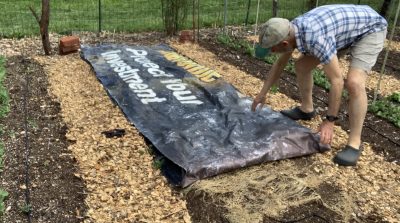
Covering the ground was for the garden’s own good. “Tarping,” as this technique is called, gets the growing season off to a weed-less start. The black cover warms the ground to awaken weed seeds. They sprout, then die as they use up their energy reserves which, without light, can’t be replenished and built up. (I first learned of this technique in J. M. Fortier’s book The Market Gardener.)
Tarping is very different from the much more common way of growing plants in holes in black plastic film, even if one purpose of the soil covering, in both cases, is to snuff out weeds. Black plastic film is left in place all season long, and then disposed of, usually in a landfill, at season’s end.
Tarping tarps might be silage cover material or — as in my case — recycled, vinyl billboard signs (black on one side). They are left in place for relatively short duration, after which time the ground can be exposed to natural rainfall and air, and is open for blanketing with compost and cover crops. After each use, tarps can be folded up and stored for re-use for many seasons more.
Prescription for Weed-lessness
Tarping is but one part of my multi-pronged approach to weed control, the others of which I detail in my book Weedless Gardening.
My garden is also weed-less because I never, and I do mean never, till the soil, whether with a rototiller, garden fork, or shovel. Preserving the natural horizonation of the soil keeps weed seeds, which are coaxed awake by exposure to light, buried within the ground and dormant. No-till also has side benefits: preserving soil organic matter, maintaining soil capillarity for more efficient water use, and not disrupting soil fungi and other creatures.
Tilling does loosen the soil structure, but I avoid soil compaction by planting everything in 3-foot-wide beds, saving the paths between the beds for foot traffic.
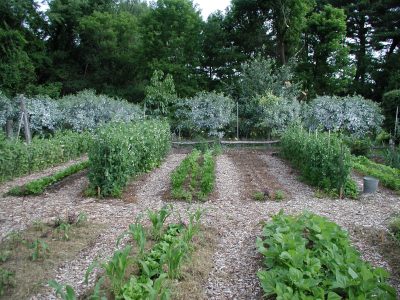
Weed-lessness is also the result of each year covering the ground with a thin layer of a more or less weed-free mulch, just half inch to an inch thick depth. This covering snuffs out small weed seeds that might be present. Other benefits are insulating to modulate wide swings in soil temperature and softening the impact of raindrops so that water percolates into the ground rather than running off.
What I use for this thin layer of mulch depends on what’s available, what I’m mulching, and, sometimes, appearance. Vegetables are hungry plants so their beds get an inch depth of ripe compost, which, besides the other benefits of mulches, also provides all the nutrition the vegetable plants need for a whole season. Paths get wood chips; it’s free, it’s pretty, and it visually sets off paths from beds. Straw, autumn leaves, sawdust, and wood shavings are some other materials that would work as well.
At the end of the season, beds that have been harvested but aren’t needed for autumn cropping, get a cover crop, which is a plant grown specifically for soil improvement.
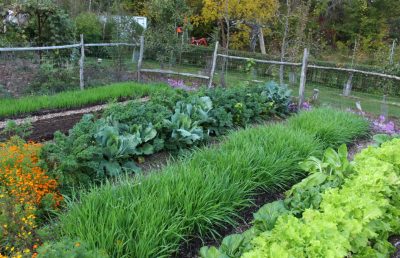
Cover crops provide all the benefits of mulches, plus looking pretty, sucking up nutrients that might otherwise wash through the soil in winter, and growing miles and miles of roots to give the soil a nice, crumbly structure. I plant oats or barley, because the plants thrive in cool autumn weather and then, here in Zone 5, are killed by winter cold sometime in January. The leaves flop down, dead, to become mulch, which I rake or roll up easily before it’s time for spring planting.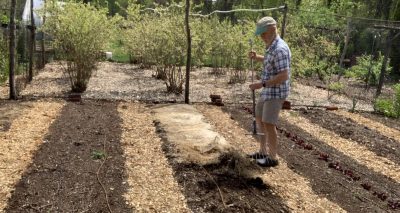
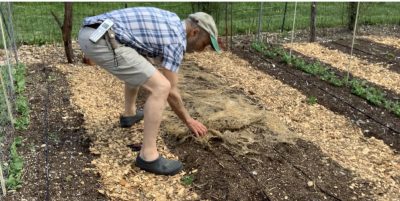
Another ploy for weed-lessness is using drip irrigation. Sure, I could get by without any watering here in the “humid Northeast,” but timely watering gets the most out of the garden. Drip irrigation pinpoints watering to garden plants rather weeds, which would, with a sprinkler, be coaxed to grow, for instance, in paths.
Weed-less but Not Weed-free
With this multi-pronged approach to weed-lessness, isn’t tarping like “taking coals to Newcastle?” No. I found that even after not tilling, mulching, using drip irrigation, and, especially, cover cropping, some weeds do a figurative “end run”and find their way into some beds. Especially, the last few years, red dead-nettle (Lamium purpureum). 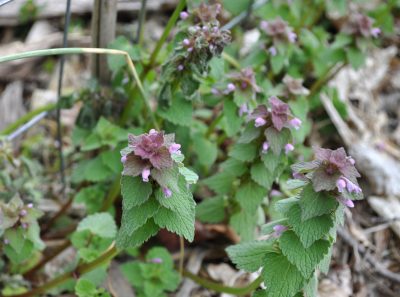 Yes, I know the plant is pretty, provides early nectar for pollinators, and is edible. But its out of place in my vegetable beds. The tarp does it in.
Yes, I know the plant is pretty, provides early nectar for pollinators, and is edible. But its out of place in my vegetable beds. The tarp does it in.
No garden can be weedless. But mine has been weed-less for many, many years.


Hi Lee,
Could not agree more about using tarps. I have also been tarping over my winter squash/pumpkin beds for years and I find it warms the soil much better than without. Makes a huge difference in getting tender pumpkin plants off to an early start. This is critical for my Zone 5A for getting 110 – 120 day varieties to fully mature and reach their full flavor profile before hard frost. And yes, it helps with the early weeds for sure.
Where can I get free wood chips? The bagged stuff has always been loaded with ticks, all kinds of ticks.
I already get your emails. Thanks!
Call local arborists or put a sign out near the street where crews can dump them at your convenience. That stuff is much better than the bagged stuff.
Hello, I live in Seattle, WA Zone 8. When is a good date to begin tapping out here. I start planting peas and potatoes mid March. Thank you.
I live in a very different climate but generally the best times for tapping is when nights are below freezing and days are in the 40s.
Lee,
Is “tapping” a typo for tarping or am I missing something?
Yes
I’ve been known to chase down a chipping truck out in my neighborhood before the crew has a chance to head to the landfill to dump those wood chips. They appreciate dumping them on my property. It saves them having to drive back into town.
I have bindweed that has made its way in to my garden. I have not been able to get rid of it, that underground root lets it survive tarping, burning, pulling, etc. What would you recommend?
Longer tarping?
Are you still able to grow early spring vegetables – some kinds of lettuce, radish, etc?
Still? Why not?
Since the tarps are on your beds through May, where, I wondered, would you plant seedlings between April and now? It is a little warmer here in Zone 6B and I am able to plant and get my first modest pickings of radish, chard and arugula by early May and lettuce by early June.
I only covered beds I set aside for later planting, such as my 3rd and 4th plantings of sweet corn.
Super idea, Lee. One that I will emulate.Thanks!
Lee, I love reading your blogs! My question about this one is, doesn’t the black plastic also kill all the good life living in the soil, kind of like sterilization?
If it gets hot enough beneath the plastic, it could kill some organisms in just the top layer. But those organisms would soon recolonize once temperatures decreased.
I noticed the blueberry bushes in the background of a few photos. How to you deal with deer in your location? Do you need a 12 foot fence to keep deer out of the garden or blueberry patch. Have you tried electric fences? Deer pressure seems to grow stronger each year (along with wood chucks).
Deer? A small amount of 8′ fencing. Two outdoor dogs (always outdoors). And vibes from me to stay away, easy since I work mostly from home.
I’m gonna look for some tarps! Thanks!
Thank you, thank you, THANK YOU, Lee. We are trying to assemble our drip irrigation, “a-la-Lee”, and it should be ready to turn on soon. Also, the white-yellow Alpine Strawberries we bought from you last year are looking beautiful. Do you feed them anything special?
Thanks for your newsletter, books, and for helping us on this gardening path in so many ways.
Your neighbors, Toni and Nick
Hi Toni,
Glad everything is going smoothly. As far as feeding, I pretty much only use compost.
My allotment is only available as of April 15th each year – should I tarp then and remove just before the Canadian long weekend in readiness for planting?
Yes, you could do that, but only if there’s nothing you want to plant before the “Canadian long weekend.”
In the fall after we clean up our vegetable beds we put down a layer of cardboard, which keeps any weeds from sprouting until we remove it in May. The cardboard is kept from blowing away by putting our flattened tomato cages on top. The cardboard breaks down a bit by May, and we just put what has not yet broken down in our garden pathways and then put a layer of mulch wood chips on top of the cardboard. Everything looks nice and neat and the vegetable beds then get a layer of compost and fresh mulch. Nothing to store and nothing in the landfill.